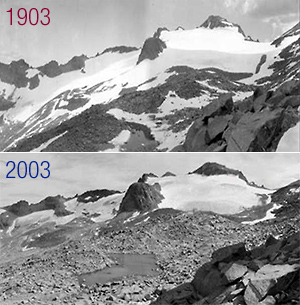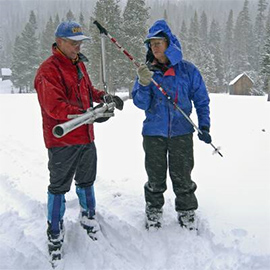Scientists From Across the Globe Warn of Drastic Water Shortages
Impact of Shrinking Snowpack, Disappearing Glaciers will Affect Hundreds of Millions
Ioana Patringenaru | May 11, 2009
In the Sierra Neveda, snowpack will shrink by 30 to 90 percent by the end of the century. On the other side of the planet, in the Himalayas, about 70 percent of glaciers are set to disappear. These changes are both caused by climate change and will lead to dramatic water shortages for hundreds of millions of people across the globe, scientists said during a press conference Wednesday at UC San Diego.
With water rationing measures just weeks away for San Diego residents, a group of scientists gathered on campus to discuss how countries and regions can ensure the future of their water resources and supplies. Hailing from as far as Great Britain, India and China, the scientists said that they shared a common goal.
“One of the most pressing issues facing the planet is how climate change is impacting water supplies and water security,” said Tony Haymet, director of UCSD’s Scripps Institution of Oceanography.
He was a moderator during the press conference—the last event during a three-day workshop presented by the Cambridge-UC San Diego Global Water Initiative. The workshop, entitled “Ice, Snow, and Water: Impacts of Climate Change on California and Himalayan Asia,” took place May 4 to 6 on campus and aimed to forge an international alliance to combat what climate experts predict will be a future with much less mountain snow in the Sierra Nevada and Himalayas.
California’s challenge

A 100-year comparison: Lyell Glacier, Yosemite National Park
In California, the Scripps Institution of Oceanography has led the way in assessing the threats posed by climate change, including water shortages, said Haymet. The institution is home to the California Climate Change Research Center and Scripps scientist Dan Cayan spearheads work in this area. A statewide report found that a rise in temperatures of 3 to 5.5 degrees Fahrenheit would lead to a 30 to 60 percent loss in the Sierra snowpack. An increase of 8 to 10 degrees would lead to a 90 percent loss.
“The causes are global, but a lot of the actions we can take are regional,” said Haymet.
The Northern Sierra Nevada is a key water source for the 20 million Southern California residents and for the agriculture-rich Central Valley. But the impact of the loss of snowpack on the availability of drinking water is unclear, said Bob Wilkinson, a researcher at UC Santa Barbara who took part in last week’s workshop. Other factors also come into play. The relationship between warming and rainfall is not well understood, Wilkinson said. For example, 2005 was a record wet year, but 2007 was a record dry year for Southern California, he said.
California has several choices to cope with water shortages. Water agencies will seek to get their customers to use water more efficiently, Wilkinson said. Re-using water also is up for debate. In Los Angeles County, major local watersheds could be replenished during wetter years, he said. “They are very important and very vital,” Wilkinson explained.
The Himalayas threatened

California Department of Water Resources officials conduct a snow survey in the Sierra Nevada. The water supply held in the mountain snowpack and elsewhere in California could be reduced by climate change, according to a report by the California Climate Action Team.
Meanwhile, Himalayan Asia faces similar issues—on a much larger scale. The monsoon, which provides water for more than 1 billion people, has become weaker and more erratic, said Julian Hunt, a scientist at Cambridge University. In 2006, tea-growing Assam, one of the wettest places on Earth, experienced a drought; but rain fell in the desert areas of northwest India for the first time in 50 years.
In China, more than 100 million people depend for their drinking water on glaciers that are set to shrink by 70 percent by the end of the century, said Yao Tendong, a researcher at the Chinese Academy of Sciences. Rivers in that area get 10 to 40 percent of their water from melting ice and snow, he added. Worse, retreating glaciers leave behind glacial lakes that could trigger catastrophic floods at any time, said Arun Shrestha, from the Nepal-based International Centre for Integrated Mountain Development.
Scientists agreed that researchers and policy-makers need to work together to produce thorough assessments of these threats, which will hopefully lead to finding solutions for the crisis. UCSD will take the lead in sharing its forecasting expertise with researchers and policy-makers from other countries, said Charles Kennel, a UCSD researcher who served as director of Scripps from 1998 to 2006.
Working together
The three-day “Ice, Snow and Water” workshop was hosted by the new Sustainability Solutions Institute created in January by UCSD Chancellor Marye Anne Fox. The institute builds upon a legacy of climate change research pioneered at the century-old Scripps Institution of Oceanography. It seeks to use the science resources amassed at UCSD —ranging from climate change research at Scripps to the networking and data-sharing power of the California Institute of Telecommunications and Information Technology (Calit2)—to promote solutions to the world’s most pressing sustainability issues.

Tony Haymet, the director of UCSD's Scripps Institution of Oceanography, spoke during a press conference Wednesday.
“We’re going to have to work at a much higher resolution of data,” said Calit2 Director Larry Smarr.
Session leaders represented the United Nations World Climate Research Program, the Chinese Academy of Sciences, the Indian Space Research Organization, the British Antarctic Survey, the California Department of Water Resources as well as several U.S. universities. Participants drafted language for a common declaration during the workshop. Workshop leaders plan to present the declaration at the 2009 Forum on Science and Technology in Society in Kyoto, Japan, which will take place in October.
“We are trying to make it known that the Himalayas are to the issue of the world’s water supply problem what the Amazon rain forest is to the issue of deforestation,” said Kennel.

|